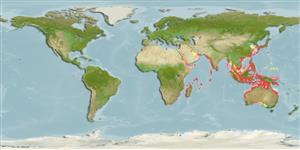Common names from other countries
分類 / Names
俗名 | 同種異名 | Catalog of Fishes(屬, 種) | ITIS | CoL | WoRMS | Cloffa
Teleostei >
Eupercaria/misc (Various families in series Eupercaria)
鱸形目 (Various families in series Eupercaria) >
Sparidae (Porgies)
鯛科 (Porgies)
Etymology: Rhabdosargus: Greek, rhabdos = stick + Latin, sargus = sargus (1591) (Ref. 45335).
More on author: Forsskål.
Environment: milieu / climate zone / depth range / distribution range
生態學
海洋; 半鹹淡水 礁區魚類; 海洋洄游的 (Ref. 51243); 深度上下限 0 - 60 m (Ref. 30573). 熱帶; 36°N - 38°S, 19°E - 155°E (Ref. 57004)
Indo-West Pacific: Red Sea and East Africa to Japan, China, and Australia.
印度-西太平洋: 紅海而且東非到日本,中國與澳洲。
Length at first maturity / 大小 / 重量 / 年齡
Maturity: Lm 23.7 range ? - ? cm
Max length : 80.0 cm TL 雄魚/尚未辨別雌雄; (Ref. 3678); common length : 45.0 cm TL 雄魚/尚未辨別雌雄; (Ref. 1724); 最大體重: 12.0 kg (Ref. 1724)
背棘 (總數) : 11; 背的軟條 (總數) : 12 - 13; 臀棘: 3; 臀鰭軟條: 10 - 11. Bright yellow mark above the pelvic base.
在腹鰭基底上面的鮮黃色的標誌。
Inhabit coastal waters (Ref. 30573, 44894), usually entering estuaries (Ref. 44894). Abundant in shallow water and often caught at the surf-line or in rock pools (Ref. 9987). Larger, solitary fish sometimes enter brackish mangrove areas (Ref. 9987). Juveniles in estuaries move into deeper water with growth (Ref. 4335). Often in schools (Ref. 9710). Feed on benthic invertebrates, mainly mollusks (Ref. 5213) and aquatic macrophytes (Ref. 26055). Popular angling species commonly captured with hook and line (Ref. 44894). Marketed fresh (Ref. 5284).
棲息於沿岸水域。 (參考文獻 30573) 豐富的在淺水區中而且時常捕獲於碎浪區或在岩石區潮池中.(參考文獻 9987) 比較大又獨居性的魚有時進入半鹹淡的紅樹林區域。 (參考文獻 9987) 河口的稚魚隨著成長移進較深的水域中。 (參考文獻 4335) 常形成魚群.(參考文獻 9710) 吃底棲的無脊椎動物, 主要地軟體動物 (參考文獻 5213) 與水生的大型植物.(參考文獻 26055) 生鮮地在市場上銷售了。 (參考文獻 5284)
Life cycle and mating behavior
Maturities | 繁殖 | Spawnings | Egg(s) | Fecundities | 仔魚
Normally sexes are separate but some individuals are protandrous due to geographical variation in sexual pattern (Ref. 103751). Gonochorism is confirmed in Australia, and protandry in Asia (Ref. 103751). Also Ref. 28504.印度-西太平洋: 紅海而且東非到日本,中國與澳洲。
Bauchot, M.-L. and M.M. Smith, 1984. Sparidae. In W. Fischer and G. Bianchi (eds.) FAO species identification sheets for fishery purposes. Western Indian Ocean (Fishing Area 51). volume 4. [var. pag.] FAO, Rome. (Ref. 3507)
IUCN 瀕危狀態 (Ref. 130435)
無危 (LC) ; Date assessed: 02 December 2009
CITES (Ref. 128078)
Not Evaluated
人類使用
漁業: 商業性; 養殖: 商業性; 游釣魚種: 是的
工具
特別的報告
下載 XML
網路資源
Estimates based on models
Preferred temperature (Ref.
115969): 21.9 - 29, mean 28 (based on 1662 cells).
Phylogenetic diversity index (Ref.
82804): PD
50 = 0.5156 [Uniqueness, from 0.5 = low to 2.0 = high].
Bayesian length-weight: a=0.01950 (0.01622 - 0.02344), b=2.96 (2.91 - 3.01), in cm Total Length, based on LWR estimates for this species (Ref.
93245).
營養階層 (Ref.
69278): 3.3 ±0.47 se; based on food items.
回復力 (Ref.
120179): 中等的, 族群倍增時間最少 1.4 - 4.4年 (Assuming tm=2-4).
Fishing Vulnerability (Ref.
59153): Moderate vulnerability (36 of 100).
Climate Vulnerability (Ref.
125649): Very high vulnerability (88 of 100).
